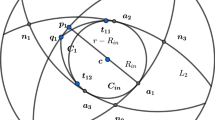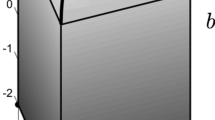Abstract
By a (ρ, c, q)-wedge in the unit ball {\(\mathbb{B}^n \subset \mathbb{C}^n \)} we mean the union of the sets {\(\mathbb{B}_\rho ^n \)} and Ec,q(e0), where {\(\mathbb{B}_\rho ^n = \left\{ {z \in \mathbb{C}^n :\left| z \right| \leqslant \rho } \right\}\)}, 0<ρ<1, |e0|=1, 0<q<1, {\(\rho > 1 - \frac{{\left( {1 - q} \right)^2 }}{{2\left( {1 + c^2 } \right)}}\)}, and {\(E_{c,q} \left( {e_0 } \right) = \left\{ {z \in \mathbb{B}^n :\left| {Im\left( {1 - \left( {z,e_0 } \right)} \right)} \right| \leqslant c{\text{ Re}}\left( {{\text{1 - }}\left( {{\text{z,}}e_0 } \right)} \right);\left| z \right|^2 - \left| {\left( {z,e_0 } \right)} \right|^2 \leqslant q\left( {1 - \left| {\left( {z,e_0 } \right)} \right|^2 } \right)} \right\}\)} (here (z,χ) is the usual scalar product in {\(\mathbb{C}^n \)}). We denote by Ta, {\({\rm T}_a \)}, a≠0, the intersection of {\(\mathbb{B}^n \)} and the hyperplane {z:(z, a)=|a|2}. This paper contains a description of the sets Z of the form {\(\bigcup\limits_{a \in A} { {\rm T}_\alpha } \)}, where A belongs to a finite union of (ρ, c, q)-wedges with 0<q<1/2. These sets may occur as zero-sets or interpolation set for functions belonging to {\(H^\infty \left( {\mathbb{B}^n } \right)\)}. Bibliography: 9 titles.
Similar content being viewed by others
References
G. M. Khenkin, “The H. Lévy equation and analysis on pseudoconvex manifolds,”Usp. Mat. Nauk,32, 57–118 (1997).
H. Skoda, “Valeurs au bord pour les solutions de l'opérateurd″, et caracterisation des zéros des fonctions de la classe de Nevanlinna,”Bull. Soc. Math. France,104, 225–299 (1976).
A. B. Aleksandrov, “The Blaschke condition and the zeros of bounded holomorphic functions,” in:Multidimensional Complex Analysis [in Russian], Krasnoyarsk (1985).
M. Hakim and N. Sibony, “Ensemble des zéros d'une fonction holomorphe bornée dans la boule unité,”Math. Ann.,260, 469–474 (1982).
N. A. Shirokov, Zap. Nauchn. Semin.LOMI,141, 183–187 (1985).
E. Amar, “Extension de fonctions analytiques avec estimation,”Arkiv Mat.,17, 123–138 (1979).
W. Rudin, Function Theory in the Unit Ball of {\(\mathbb{C}^n \)} Springer-Verlag, New York-Heidelberg-Berlin (1980).
N. A. Shirokov, “Traces ofH ∞-functions on hyperplanes,”Lect. Notes Math.,1043, 577–578 (1984).
D. J. Newman, “Interpolation inH ∞,”Trans. Am. Math. Soc.,22, 501–507 (1959).
Additional information
Translated fromZapiski Nauchnykh Seminarov POMI, Vol. 247, 1997, pp. 276–297.
Translated by S. V. Kislyakov.
Rights and permissions
About this article
Cite this article
Shirokov, N.A. An analog of the Stolz Angle for the unit ball in {\(\mathbb{C}^n \)}. J Math Sci 101, 3216–3229 (2000). https://doi.org/10.1007/BF02673746
Received:
Issue Date:
DOI: https://doi.org/10.1007/BF02673746




